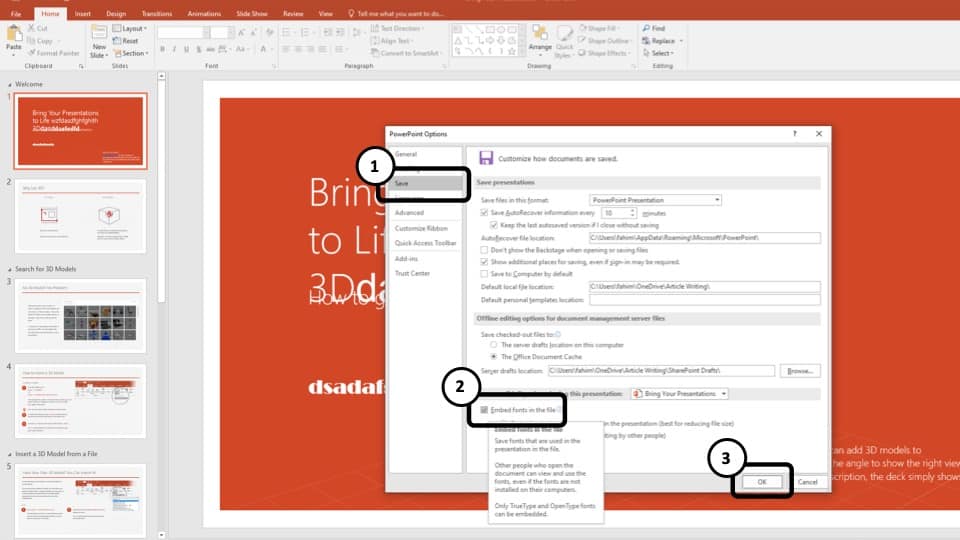
Consider zipping the fonts and PPTX file together so it’s more obvious that they’re required. I’ve found you need to follow up prior to presenting to make sure the fonts are installed because it is a minor step that is frequently overlooked. You then need to hope the audio/visual team for the event installs them, which can be a low priority for a very busy team.
Provide custom fonts: If you need to present your slides on an external computer, you can provide the custom fonts along with your presentation. In some cases, this may not be an option at a conference where the audio/visual team wants to standardize the hardware being used or at an organization that doesn’t allow outside computers (security precautions). Use your own computer: If you’ve used several custom fonts, you can insist on presenting from your own machine. If you present or share slides externally, here are some options for avoiding font problems: The substituted font messed up the text in several spots. On the right, you see what PowerPoint substituted when the computer didn’t have the same font. On the left, I’ve zoomed into part of the slide which is using the right custom font. This experience highlights the importance of always checking what your slides look like on a different machine before presenting–something I failed to do and paid the price. Not only was I embarrassed, but the slide failed to communicate effectively to my audience. I noticed it because all of the labels on one slide were a jumble of text (see below). After joking about being the PowerPoint Ninja at the beginning of my presentation, I noticed to my horror that the inserted slides used the corporate font. At one industry event, I inserted a couple of slides from another co-worker into my slide deck. I do use them from time to time, but I’ve learned to be very careful with them. In general, I’ve avoided using custom fonts because of the problems they create. However, they can trip up employees when they present on external computers or share slides with another company. The corporate fonts are unique, clean, and professional. My company, Adobe, has its own set of corporate fonts, which is both good and bad. In my current role as an analytics evangelist, I’m not always presenting from my own computer. While it can be an occasional problem for internal computers, it can be a serious problem when presenting on external computers or sharing PowerPoint files outside of your company. No, Arial and Helvetica are not the same. PCs don’t have Helvetica by default like Macs. If you have both PCs and Macs at your workplace, it’s also common to run into font compatibility problems because PCs and Macs don’t share all the same fonts (e.g., PCs don’t have the Helvetica font by default). When it comes to setting up a new computer or re-imaging an existing computer (i.e., restoring a computer to its default state typically after a bad crash or virus), fonts aren’t going to be the highest priority for IT. POWERPOINT FOR MAC EMBEDDED FONTS INSTALL
However, I’ve still seen problems with custom corporate fonts when your IT team fails to install these fonts on all new computers or re-imaged computers.

In most cases, a non-standard or custom corporate font isn’t going to cause problems internally because theoreticallyeveryone at your company should have the corporate font installed. In other words, your nicely designed slides can turn into an unintelligible, sloppy-looking mess simply because the computer you’re presenting on doesn’t have the right font. As a result, all of your copy and labels may end up being misaligned or text-wrap in places you didn’t anticipate. Why? When people go to view your file on their computers and they don’t have the same font, PowerPoint will substitute another font which may not be the exact same size or style as your original font (12 pt in one font can be smaller or larger in another font). You may hate Microsoft’s default fonts (e.g., Arial), but if you’re considering using another font you’ll want to make sure it’s a commonly installed font.

If we do not have a tutorial for your version of PowerPoint, explore the version closest to the one you use.When picking fonts for presentations or corporate PowerPoint templates, you need to be careful which fonts you choose.

To learn more, choose your version of PowerPoint. The best solution to this problem is to use safe fonts that are available on most computers, or you may also explore the option to embed fonts in your PowerPoint presentation. Have you ever been in a situation where your presentation looked so awesome with some amazing typography, but when you opened the same presentation on another computer, the text looked positively terrible! This behavior may happen if the font you used is not available on the other computer.







 0 kommentar(er)
0 kommentar(er)
